stop start FIAT DOBLO COMBI 2012 Owner handbook (in English)
[x] Cancel search | Manufacturer: FIAT, Model Year: 2012, Model line: DOBLO COMBI, Model: FIAT DOBLO COMBI 2012Pages: 283, PDF Size: 6.31 MB
Page 206 of 283
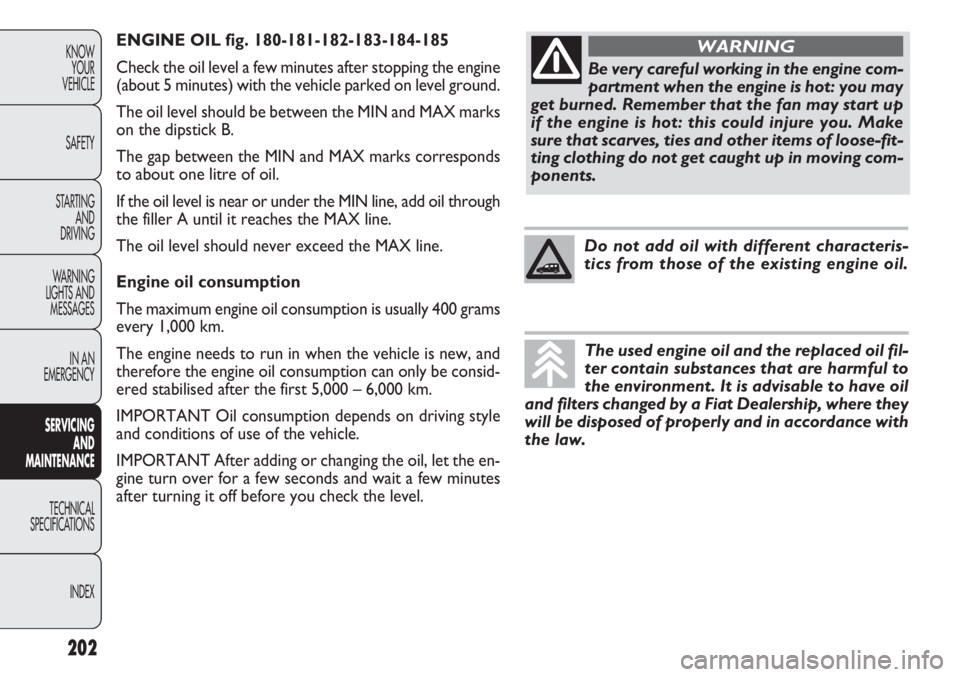
ENGINE OIL fig. 180-181-182-183-184-185
Check the oil level a few minutes after stopping the engine
(about 5 minutes) with the vehicle parked on level ground.
The oil level should be between the MIN and MAX marks
on the dipstick B.
The gap between the MIN and MAX marks corresponds
to about one litre of oil.
If the oil level is near or under the MIN line, add oil through
the filler A until it reaches the MAX line.
The oil level should never exceed the MAX line.
Engine oil consumption
The maximum engine oil consumption is usually 400 grams
every 1,000 km.
The engine needs to run in when the vehicle is new, and
therefore the engine oil consumption can only be consid-
ered stabilised after the first 5,000 – 6,000 km.
IMPORTANT Oil consumption depends on driving style
and conditions of use of the vehicle.
IMPORTANT After adding or changing the oil, let the en-
gine turn over for a few seconds and wait a few minutes
after turning it off before you check the level.
202
KNOWYOUR
VEHICLE
SAFETY
STARTING AND
DRIVING
WARNING
LIGHTS AND MESSAGES
IN AN
EMERGENCY
SERV IC
ING
AND
MAINTENANCE
TECHNICAL
SPECIFICA TIONS
INDEX
Be very careful working in the engine com-
partment when the engine is hot: you may
get burned. Remember that the fan may start up
if the engine is hot: this could injure you. Make
sure that scarves, ties and other items of loose-fit-
ting clothing do not get caught up in moving com-
ponents.
WARNING
Do not add oil with different characteris-
tics from those of the existing engine oil.
The used engine oil and the replaced oil fil-
ter contain substances that are harmful to
the environment. It is advisable to have oil
and filters changed by a Fiat Dealership, where they
will be disposed of properly and in accordance with
the law.
Page 213 of 283
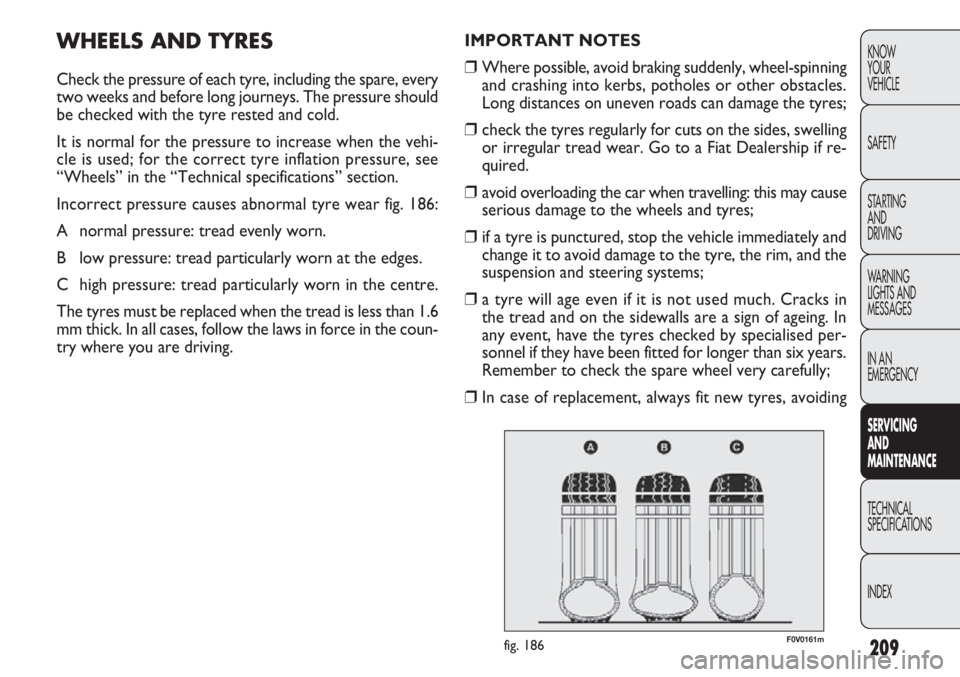
209
KNOW
YOUR
VEHICLE
SAFETY
STARTING
AND
DRIVING
WARNING
LIGHTS AND
MESSAGES
IN AN
EMERGENCY
SERVIC
ING
AND
MAINTENANCE
TECHNICAL
SPECIFICA TIONS
INDEX
IMPORTANT NOTES
❒ Where possible, avoid braking suddenly, wheel-spinning
and crashing into kerbs, potholes or other obstacles.
Long distances on uneven roads can damage the tyres;
❒ check the tyres regularly for cuts on the sides, swelling
or irregular tread wear. Go to a Fiat Dealership if re-
quired.
❒ avoid overloading the car when travelling: this may cause
serious damage to the wheels and tyres;
❒ if a tyre is punctured, stop the vehicle immediately and
change it to avoid damage to the tyre, the rim, and the
suspension and steering systems;
❒ a tyre will age even if it is not used much. Cracks in
the tread and on the sidewalls are a sign of ageing. In
any event, have the tyres checked by specialised per-
sonnel if they have been fitted for longer than six years.
Remember to check the spare wheel very carefully;
❒ In case of replacement, always fit new tyres, avoidingWHEELS AND TYRES
Check the pressure of each tyre, including the spare, every
two weeks and before long journeys. The pressure should
be checked with the tyre rested and cold.
It is normal for the pressure to increase when the vehi-
cle is used; for the correct tyre inflation pressure, see
“Wheels” in the “Technical specifications” section.
Incorrect pressure causes abnormal tyre wear fig. 186:
A normal pressure: tread evenly worn.
B low pressure: tread particularly worn at the edges.
C high pressure: tread particularly worn in the centre.
The tyres must be replaced when the tread is less than 1.6
mm thick. In all cases, follow the laws in force in the coun-
try where you are driving.
F0V0161mfig. 186
Page 220 of 283
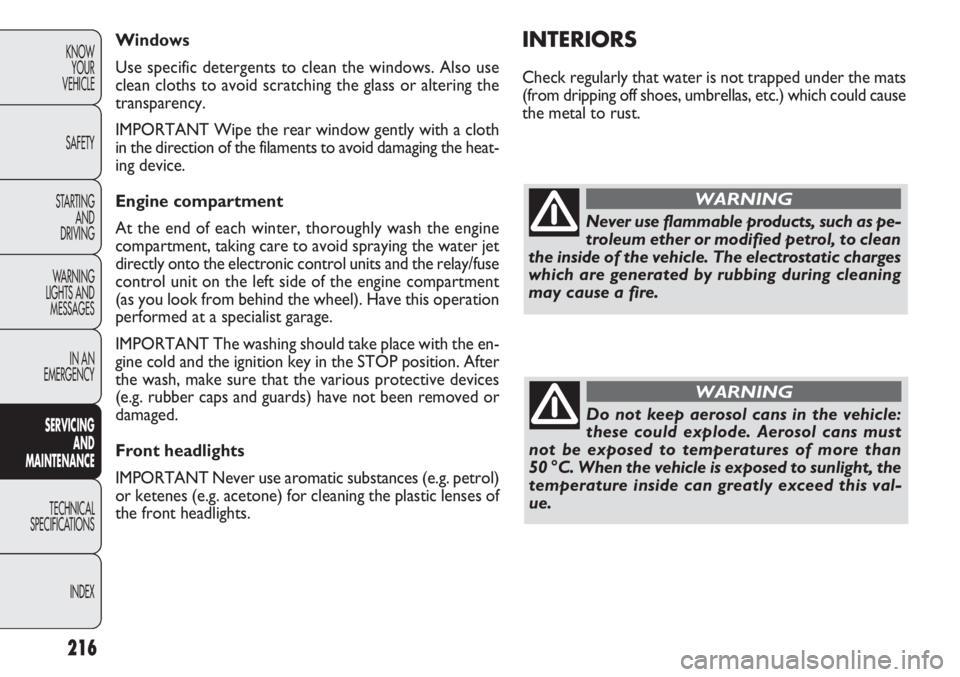
216
KNOWYOUR
VEHICLE
SAFETY
STARTING AND
DRIVING
WARNING
LIGHTS AND MESSAGES
IN AN
EMERGENCY
SERV IC
ING
AND
MAINTENANCE
TECHNICAL
SPECIFICA TIONS
INDEX
INTERIORS
Check regularly that water is not trapped under the mats
(from dripping off shoes, umbrellas, etc.) which could cause
the metal to rust.
Windows
Use specific detergents to clean the windows. Also use
clean cloths to avoid scratching the glass or altering the
transparency.
IMPORTANT Wipe the rear window gently with a cloth
in the direction of the filaments to avoid damaging the heat-
ing device.
Engine compartment
At the end of each winter, thoroughly wash the engine
compartment, taking care to avoid spraying the water jet
directly onto the electronic control units and the relay/fuse
control unit on the left side of the engine compartment
(as you look from behind the wheel). Have this operation
performed at a specialist garage.
IMPORTANT The washing should take place with the en-
gine cold and the ignition key in the STOP position. After
the wash, make sure that the various protective devices
(e.g. rubber caps and guards) have not been removed or
damaged.
Front headlights
IMPORTANT Never use aromatic substances (e.g. petrol)
or ketenes (e.g. acetone) for cleaning the plastic lenses of
the front headlights.
Never use flammable products, such as pe-
troleum ether or modified petrol, to clean
the inside of the vehicle. The electrostatic charges
which are generated by rubbing during cleaning
may cause a fire.
WARNING
Do not keep aerosol cans in the vehicle:
these could explode. Aerosol cans must
not be exposed to temperatures of more than
50 °C. When the vehicle is exposed to sunlight, the
temperature inside can greatly exceed this val-
ue.
WARNING
Page 253 of 283
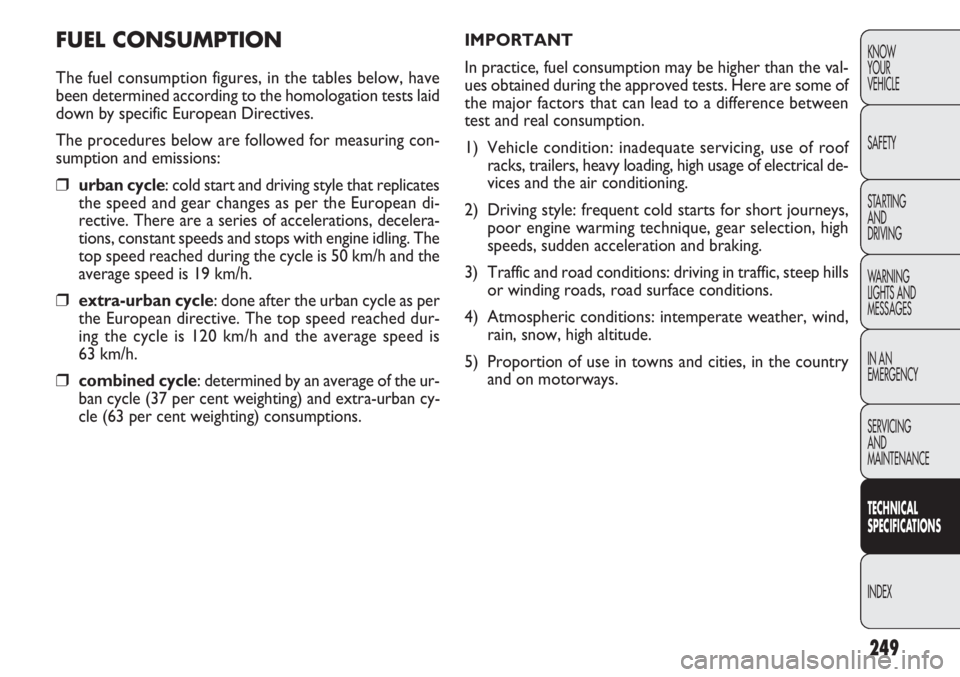
249
KNOW
YOUR
VEHICLE
SAFETY
STARTING
AND
DRIVING
WARNING
LIGHTS AND
MESSAGES
IN AN
EMERGENCY
SERVICING
AND
MAINTENANCE
TECHNICAL
SPECIFICATIO
NS
INDEX
FUEL CONSUMPTION
The fuel consumption figures, in the tables below, have
been determined according to the homologation tests laid
down by specific European Directives.
The procedures below are followed for measuring con-
sumption and emissions:
❒urban cycle: cold start and driving style that replicates
the speed and gear changes as per the European di-
rective. There are a series of accelerations, decelera-
tions, constant speeds and stops with engine idling. The
top speed reached during the cycle is 50 km/h and the
average speed is 19 km/h.
❒extra-urban cycle: done after the urban cycle as per
the European directive. The top speed reached dur-
ing the cycle is 120 km/h and the average speed is
63 km/h.
❒combined cycle: determined by an average of the ur-
ban cycle (37 per cent weighting) and extra-urban cy-
cle (63 per cent weighting) consumptions. IMPORTANT
In practice, fuel consumption may be higher than the val-
ues obtained during the approved tests. Here are some of
the major factors that can lead to a difference between
test and real consumption.
1) Vehicle condition: inadequate servicing, use of roof
racks, trailers, heavy loading, high usage of electrical de-
vices and the air conditioning.
2) Driving style: frequent cold starts for short journeys, poor engine warming technique, gear selection, high
speeds, sudden acceleration and braking.
3) Traffic and road conditions: driving in traffic, steep hills or winding roads, road surface conditions.
4) Atmospheric conditions: intemperate weather, wind, rain, snow, high altitude.
5) Proportion of use in towns and cities, in the country and on motorways.
Page 254 of 283
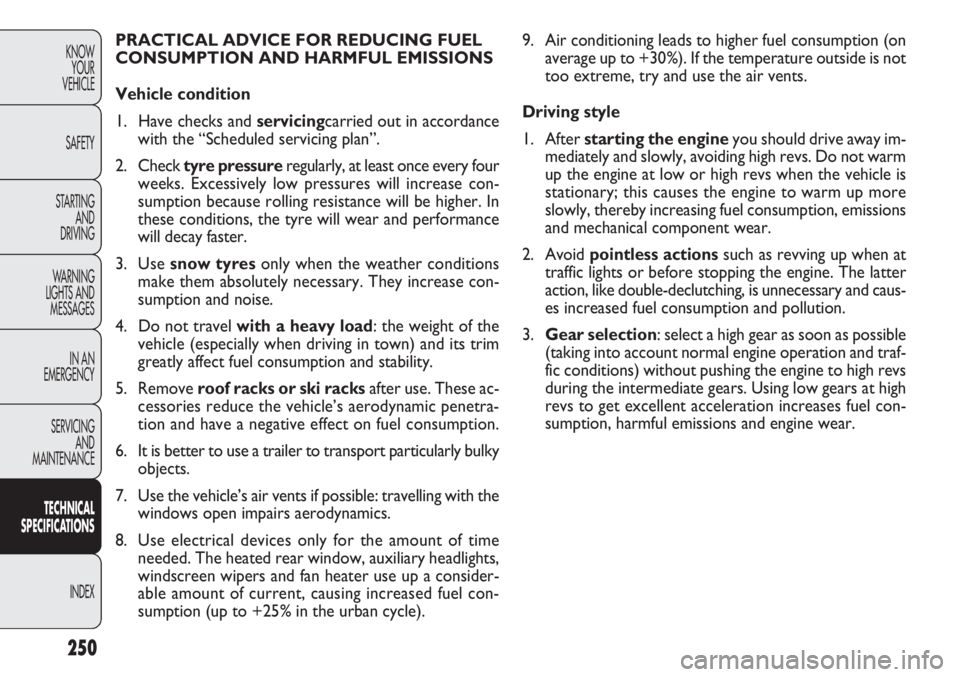
250
KNOWYOUR
VEHICLE
SAFETY
STARTING AND
DRIVING
WARNING
LIGHTS AND MESSAGES
IN AN
EMERGENCY
SERVICING AND
MAINTENANCE
TECHNICAL
SPECIFICAT IO
NS
INDEX
9. Air conditioning leads to higher fuel consumption (on average up to +30%). If the temperature outside is not
too extreme, try and use the air vents.
Driving style
1. After starting the engine you should drive away im-
mediately and slowly, avoiding high revs. Do not warm
up the engine at low or high revs when the vehicle is
stationary; this causes the engine to warm up more
slowly, thereby increasing fuel consumption, emissions
and mechanical component wear.
2. Avoid pointless actions such as revving up when at
traffic lights or before stopping the engine. The latter
action, like double-declutching, is unnecessary and caus-
es increased fuel consumption and pollution.
3. Gear selection: select a high gear as soon as possible
(taking into account normal engine operation and traf-
fic conditions) without pushing the engine to high revs
during the intermediate gears. Using low gears at high
revs to get excellent acceleration increases fuel con-
sumption, harmful emissions and engine wear.
PRACTICAL ADVICE FOR REDUCING FUEL
CONSUMPTION AND HARMFUL EMISSIONS
Vehicle condition
1. Have checks and
servicingcarried out in accordance
with the “Scheduled servicing plan”.
2. Check tyre pressure regularly, at least once every four
weeks. Excessively low pressures will increase con-
sumption because rolling resistance will be higher. In
these conditions, the tyre will wear and performance
will decay faster.
3. Use snow tyres only when the weather conditions
make them absolutely necessary. They increase con-
sumption and noise.
4. Do not travel with a heavy load: the weight of the
vehicle (especially when driving in town) and its trim
greatly affect fuel consumption and stability.
5. Remove roof racks or ski racks after use. These ac-
cessories reduce the vehicle’s aerodynamic penetra-
tion and have a negative effect on fuel consumption.
6. It is better to use a trailer to transport particularly bulky objects.
7. Use the vehicle’s air vents if possible: travelling with the windows open impairs aerodynamics.
8. Use electrical devices only for the amount of time needed. The heated rear window, auxiliary headlights,
windscreen wipers and fan heater use up a consider-
able amount of current, causing increased fuel con-
sumption (up to +25% in the urban cycle).
Page 255 of 283
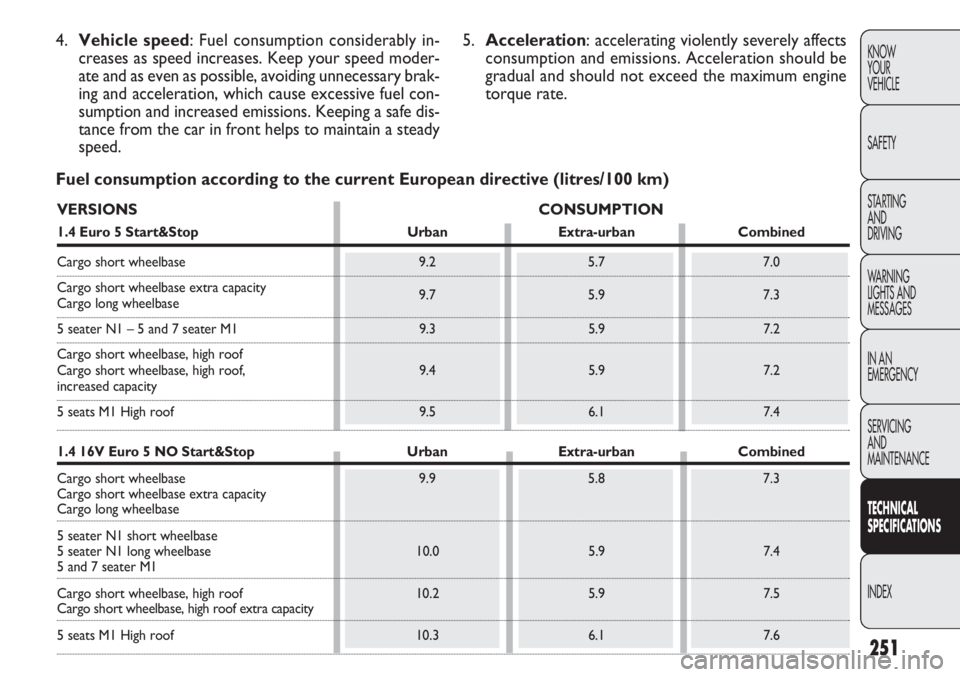
251
KNOW
YOUR
VEHICLE
SAFETY
STARTING
AND
DRIVING
WARNING
LIGHTS AND
MESSAGES
IN AN
EMERGENCY
SERVICING
AND
MAINTENANCE
TECHNICAL
SPECIFICATIO
NS
INDEX
4. Vehicle speed: Fuel consumption considerably in-
creases as speed increases. Keep your speed moder-
ate and as even as possible, avoiding unnecessary brak-
ing and acceleration, which cause excessive fuel con-
sumption and increased emissions. Keeping a safe dis-
tance from the car in front helps to maintain a steady
speed. 5.
Acceleration: accelerating violently severely affects
consumption and emissions. Acceleration should be
gradual and should not exceed the maximum engine
torque rate.
Fuel consumption according to the current European directive (litres/10\
0 km)
VERSIONS CONSUMPTION
1.4 Euro 5 Start&Stop UrbanExtra-urban Combined
Cargo short wheelbase 9.25.7 7.0
Cargo short wheelbase extra capacity 9.75.9 7.3
Cargo long wheelbase
5 seater N1 – 5 and 7 seater M1 9.35.9 7.2
Cargo short wheelbase, high roof
Cargo short wheelbase, high roof, 9.45.9 7.2
increased capacity
5 seats M1 High roof 9.56.1 7.4
1.4 16V Euro 5 NO Start&Stop UrbanExtra-urban Combined
Cargo short wheelbase 9.95.8 7.3
Cargo short wheelbase extra capacity
Cargo long wheelbase
5 seater N1 short wheelbase
5 seater N1 long wheelbase 10.0 5.9 7.4
5 and 7 seater M1
Cargo short wheelbase, high roof 10.2 5.9 7.5
Cargo short wheelbase, high roof extra capacity
5 seats M1 High roof 10.36.1 7.6
Page 256 of 283
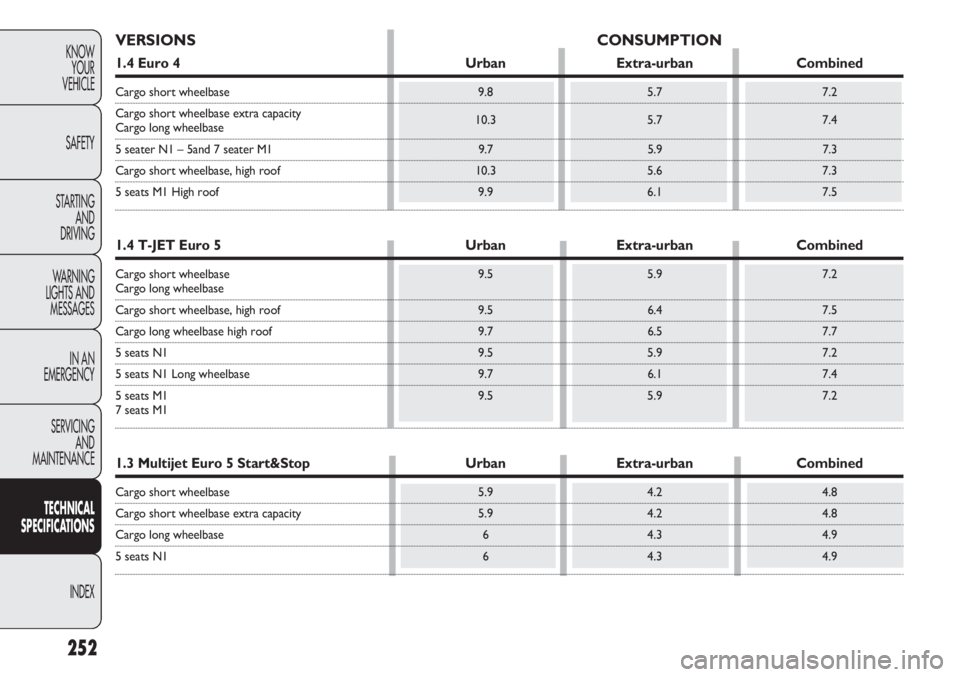
252
KNOWYOUR
VEHICLE
SAFETY
STARTING AND
DRIVING
WARNING
LIGHTS AND MESSAGES
IN AN
EMERGENCY
SERVICING AND
MAINTENANCE
TECHNICAL
SPECIFICAT IO
NS
INDEX
VERSIONS CONSUMPTION
1.4 Euro 4UrbanExtra-urban Combined
Cargo short wheelbase 9.85.7 7.2
Cargo short wheelbase extra capacity 10.35.7 7.4
Cargo long wheelbase
5 seater N1 – 5and 7 seater M1 9.75.9 7.3
Cargo short wheelbase, high roof 10.35.6 7.3
5 seats M1 High roof 9.96.1 7.5
1.4 T-JET Euro 5 UrbanExtra-urban Combined
Cargo short wheelbase 9.55.9 7.2Cargo long wheelbase
Cargo short wheelbase, high roof 9.56.4 7.5
Cargo long wheelbase high roof 9.76.5 7.7
5 seats N1 9.55.9 7.2
5 seats N1 Long wheelbase 9.76.1 7.4
5 seats M1 9.55.9 7.2
7 seats M1
1.3 Multijet Euro 5 Start&Stop UrbanExtra-urban Combined
Cargo short wheelbase 5.94.2 4.8
Cargo short wheelbase extra capacity 5.94.2 4.8
Cargo long wheelbase 64.3 4.9
5 seats N1 64.3 4.9
Page 257 of 283
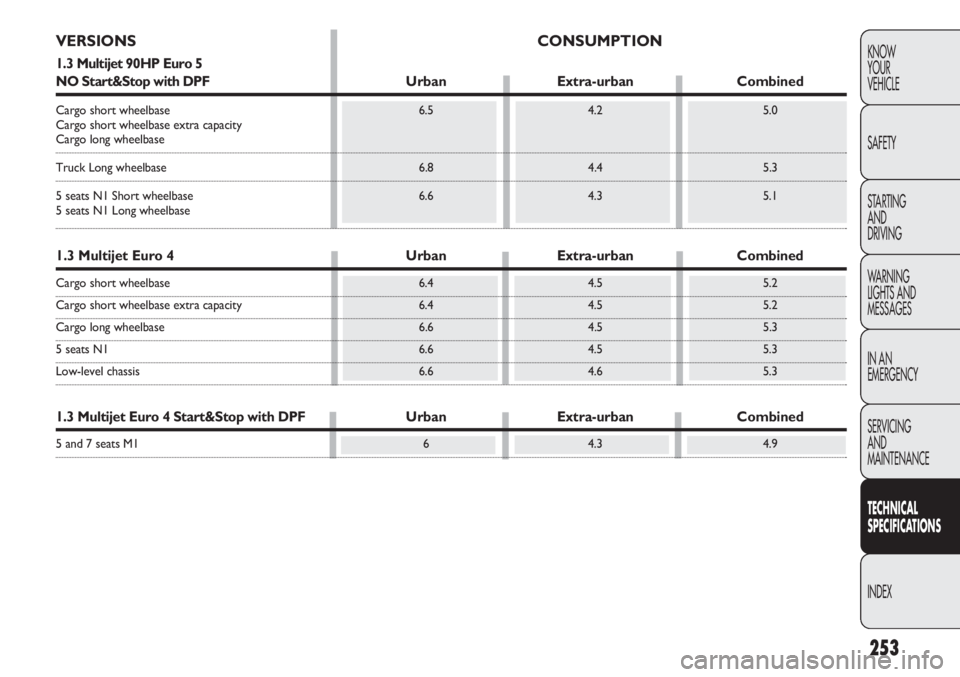
253
KNOW
YOUR
VEHICLE
SAFETY
STARTING
AND
DRIVING
WARNING
LIGHTS AND
MESSAGES
IN AN
EMERGENCY
SERVICING
AND
MAINTENANCE
TECHNICAL
SPECIFICATIO
NS
INDEX
VERSIONS CONSUMPTION
1.3 Multijet 90HP Euro 5
NO Start&Stop with DPFUrbanExtra-urban Combined
Cargo short wheelbase 6.54.2 5.0
Cargo short wheelbase extra capacity
Cargo long wheelbase
Truck Long wheelbase 6.84.4 5.3
5 seats N1 Short wheelbase 6.64.3 5.1
5 seats N1 Long wheelbase
1.3 Multijet Euro 4 UrbanExtra-urban Combined
Cargo short wheelbase 6.44.5 5.2
Cargo short wheelbase extra capacity 6.44.5 5.2
Cargo long wheelbase 6.64.5 5.3
5 seats N1 6.64.5 5.3
Low-level chassis 6.64.6 5.3
1.3 Multijet Euro 4 Start&Stop with DPF UrbanExtra-urban Combined
5 and 7 seats M1 64.3 4.9
Page 258 of 283
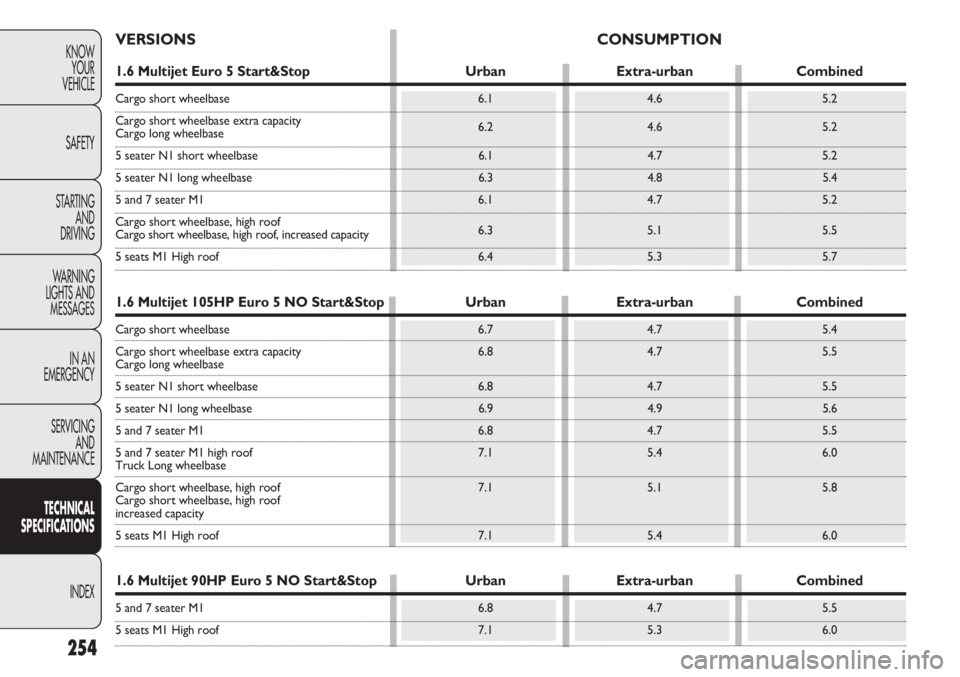
254
KNOWYOUR
VEHICLE
SAFETY
STARTING AND
DRIVING
WARNING
LIGHTS AND MESSAGES
IN AN
EMERGENCY
SERVICING AND
MAINTENANCE
TECHNICAL
SPECIFICAT IO
NS
INDEX
VERSIONS CONSUMPTION
1.6 Multijet Euro 5 Start&StopUrbanExtra-urban Combined
Cargo short wheelbase 6.14.6 5.2
Cargo short wheelbase extra capacity 6.24.6 5.2
Cargo long wheelbase
5 seater N1 short wheelbase 6.14.7 5.2
5 seater N1 long wheelbase 6.34.8 5.4
5 and 7 seater M1 6.14.7 5.2
Cargo short wheelbase, high roof
Cargo short wheelbase, high roof, increased capacity 6.3 5.1 5.5
5 seats M1 High roof
6.45.3 5.7
1.6 Multijet 105HP Euro 5 NO Start&Stop UrbanExtra-urban Combined
Cargo short wheelbase 6.74.7 5.4
Cargo short wheelbase extra capacity 6.84.7 5.5
Cargo long wheelbase
5 seater N1 short wheelbase 6.84.7 5.5
5 seater N1 long wheelbase 6.94.9 5.6
5 and 7 seater M1 6.84.7 5.5
5 and 7 seater M1 high roof 7.15.4 6.0
Truck Long wheelbase
Cargo short wheelbase, high roof 7.15.1 5.8
Cargo short wheelbase, high roof
increased capacity
5 seats M1 High roof 7.15.4 6.0
1.6 Multijet 90HP Euro 5 NO Start&Stop UrbanExtra-urban Combined
5 and 7 seater M1 6.84.7 5.5
5 seats M1 High roof 7.15.3 6.0
Page 259 of 283
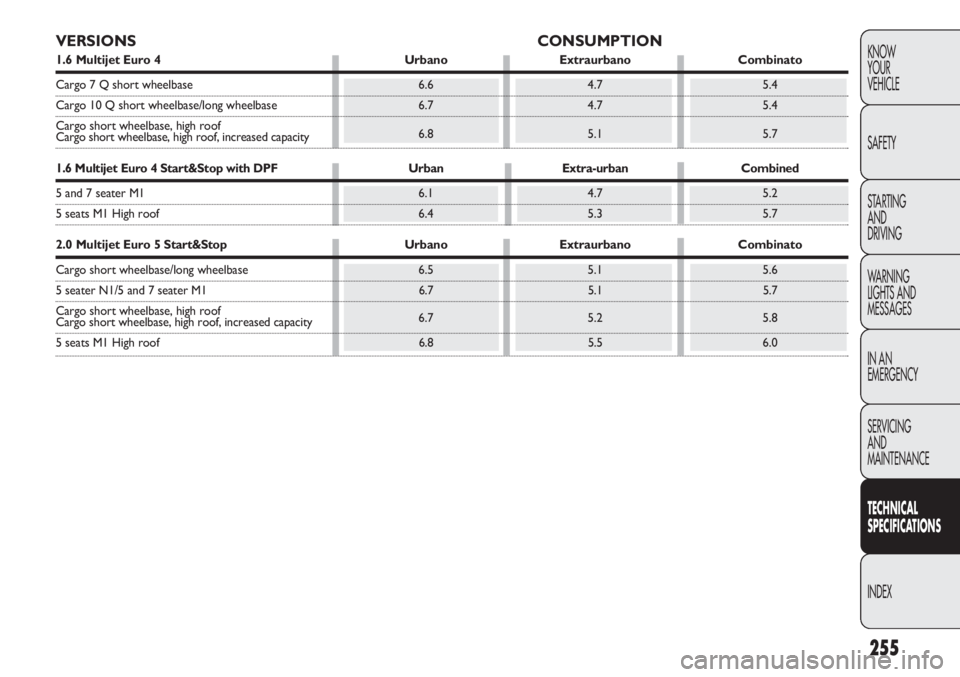
255
KNOW
YOUR
VEHICLE
SAFETY
STARTING
AND
DRIVING
WARNING
LIGHTS AND
MESSAGES
IN AN
EMERGENCY
SERVICING
AND
MAINTENANCE
TECHNICAL
SPECIFICATIO
NS
INDEX
VERSIONS CONSUMPTION
1.6 Multijet Euro 4 UrbanoExtraurbano Combinato
Cargo 7 Q short wheelbase 6.64.7 5.4
Cargo 10 Q short wheelbase/long wheelbase 6.74.7 5.4
Cargo short wheelbase, high roof
Cargo short wheelbase, high roof, increased capacity 6.8 5.1 5.7
1.6 Multijet Euro 4 Start&Stop with DPF
UrbanExtra-urban Combined
5 and 7 seater M1 6.14.7 5.2
5 seats M1 High roof 6.45.3 5.7
2.0 Multijet Euro 5 Start&Stop UrbanoExtraurbano Combinato
Cargo short wheelbase/long wheelbase 6.55.1 5.6
5 seater N1/5 and 7 seater M1 6.75.1 5.7
Cargo short wheelbase, high roof
Cargo short wheelbase, high roof, increased capacity 6.7 5.2 5.8
5 seats M1 High roof
6.85.5 6.0